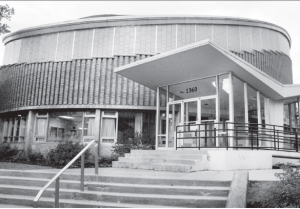
As a little girl, Alyson Petsche wasn’t one for dress-up, tea time or creating imaginary lives for Barbies in pink-roofed homes.
This caused her to be known as a tomboy, but she didn’t think about it like that.
“I never wanted to play with dollhouses – I just wanted to build them,” says Alyson, whose passion for taking things apart and recreating them began before kindergarten.
In previously male-dominated fields such as medicine and law, Canada has seen a dramatic change in the amount of women becoming health care professionals and lawyers.
However, engineering has yet to see that change.
“My mom always shopped for me in the boys’ aisle, because that’s where the science-y things were. It never occurred to me that science toys weren’t meant for girls. I just liked bug catchers and telescopes.”
In Canadian universities, the average enrollment for women in engineering sits at just 18 per cent.
Alyson, a third-year mechanical student at Dalhousie University, is part of this small statistic. Looking back, she realizes that even the word engineer was completely foreign to her until a friend mentioned it. When she did, she fell in love. It seemed like everything she wanted in a career – trades and academics rolled into one.
She also remembers teachers in high school and even elementary mentioning the word engineering in science and math classes, which she always excelled in.
But they were never looking in her direction.
They were looking at the boys.
“Growing up, girls aren’t exposed to things like designing and building the way their brothers are,” she says.
Jane Thorburn, assistant dean of engineering and assistant professor in the civil department at Dal, is disappointed.
She believes having a low number of female engineering professors and working engineers means that girls aren’t being encouraged to become engineers themselves.
According to Jane, the engineering department has only had a female enrolment of 20 per cent, a number that hasn’t changed over the past 10 years.
As an employee of the school for over 21 years, she’s still waiting for that number to rise. In over two decades, it has yet to happen.
“I’m worried,” Jane admits. “We haven’t had a decrease, but we also haven’t had an increase. We’re stuck.”
While the low number is a clear indication that engineering will continue to be a male-dominated field longer than Jane hoped, she sees a bit of a silver lining. She says that the lack of female students in the department has caused them to work harder than their male classmates.
“It’s a sad motivation, but the women in engineering at Dal tend to have higher GPAs than our male students. It’s great that they’re succeeding so well aca- demically, but I think a lot of it comes from feeling like they have to prove themselves.”
Jane knows the feeling all too well.
She studied civil engineering at the University of New Brunswick, where she spent the era of bell bottoms and Led Zeppelin reading books like Design of Structural Elements and The Mechanics of Soils and Foundations.
While Jane’s family was supportive of her decision, there was a lack of support in the school, where the percentage of female enrolment in engineering stood at just 3.6 per cent nationwide.
“I remember it being a big deal to other students that women were studying engineering, not realizing that by the time 2014 rolled around, it still would be,” says Jane. “I hoped there would be more change by now. I’m still waiting.”
According to the Ontario Society of Professional Engineers, only seven per cent of working engineers in Canada are women.
By the end of Alyson’s second year, she has taken 12 engineering courses. So far, only one of her professors has been female.
According to Jane, having just seven per cent of female engineer’s in the country means much more than just an imbalanced gender scale in the lunchroom – it means that a very small number of women are helping to make the changes the world wants and needs to see.
When Alyson first came to university, she never thought about being a minority until she entered the classroom.
“You can’t hide from being a girl. Sitting in class, all you have to do is look around to see the gap. It’s been that way since day one, and even though it’s not always easy, it’s helped create a sense of community among girls in the whole department.”
Monika Palinkas, a bubbly, Serbian-born athlete, has a slightly different story.
The chemical engineering student is in her third year at Queen’s University, where the female enrolment in engineering is just over 30 per cent. That’s more than 10 per cent higher than the national average.
She thinks the reason Queen’s has a higher rate than other schools is because of the non- competitive and teamwork-oriented nature that exists within the department.
“It’s almost impossible for the average student to get through their engineering degree on their own,” says Monika. “There’s a great deal of teamwork involved almost constantly, and the amount of spirit in the school, particularly in math and science, is amazing.”
While she’s proud of Queen’s for being recognized as the leading school in female engineers in Canada, she acknowledges that the number isn’t near where it should be. Despite the disappointing statistics, she’s optimistic that things will change, saying that women have come a long way in terms of education and the work force.
“The shift of females receiving post-secondary education is a fairly new one. In the past, white males were the only people present in schools, and that’s completely changed where they’ve become the minority.”
She also believes that the solution to the problem starts with a social change in how parents treat their daughters and how teachers treat their students.
“What we’re exposed to at a young age shapes our future interests and abilities,” says Monika. “We’re starting to see some change.”
Part of this change includes Lego’s introduction of “female-friendly” colours in order to encourage girls to build things. While Alyson doesn’t necessarily think they’re taking the best approach, as long as she sees more girls in engineering, she won’t complain.
On the topic of positive thinking, Alyson points out the advantages in a lack of female engineers. For example, professors are more likely to remember who you are.
She also jokes about having more options when it comes to dating, saying, “The odds are good, but the goods are odd.” But even the big advantages don’t outweigh the disadvantages.
“When it comes to the industry,” Alyson says, “some companies actually need to hire a certain percentage of girls, ultimately meaning that women are more likely to get hired than men. A part of me thinks, ‘Great, an advantage!’ but an even bigger part of me thinks, ‘Why?’ I want to get a job based on my abilities, not my gender.”
Over the past couple of years, Alyson has found that her male classmates have what she believes to be preconceived expectations of women in the program, which comes to light during lab work.
She is almost always asked to write the report when being placed in a group rather than to do hands on work with everyone else.
“I don’t think it’s intentional to make me or other girls in the program do the writing, but I feel like the guys I’m paired up with assume writing is the role girls want in group projects, and it’s not,” she says. “But it’s hard to say no when you’re the only girl out of four other guys and they all look at you and ask if you’ll do it.”
While Alyson sometimes gets teased for being a girl in a class full of boys, she always laughs the jokes off. She hopes one day, there won’t be anything funny about it.
Until then, she’s keeping her head and GPA high.







